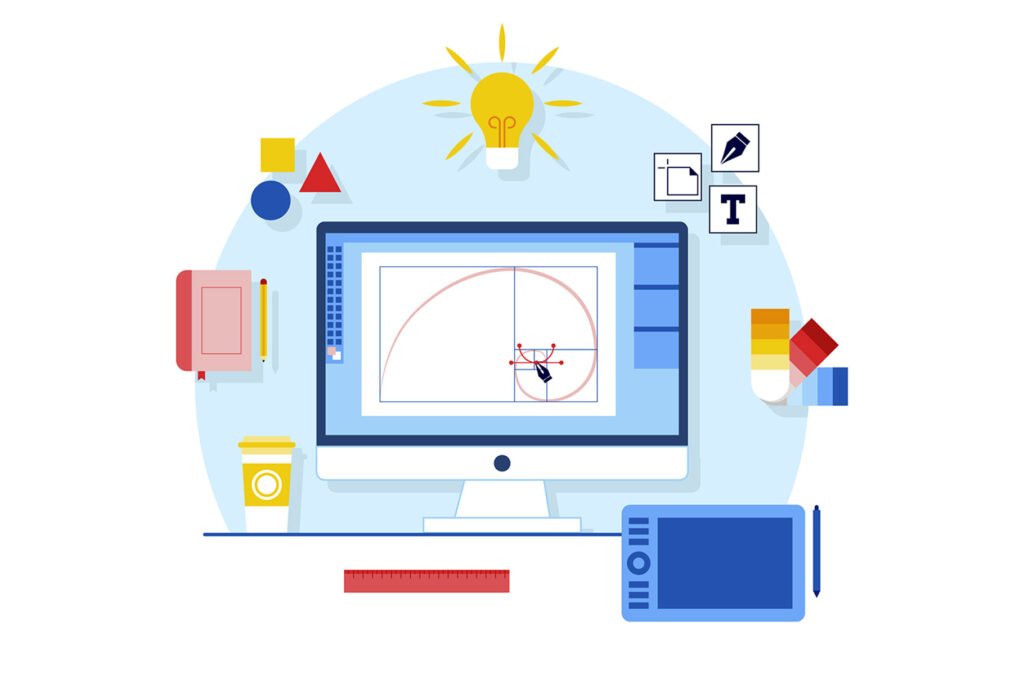Graphic design is a multi-disciplinary field that combines visual art, typography, and page layout to create a variety of communication media such as logos, websites, magazines, and books.
Graphic design is an important part of any culture because it helps us to access the information we need such as product information or text messages from our friends and family.
It can also help us communicate ideas, feelings, and emotions to other people. Graphic design can be used to promote a product or service, or it can be used as a medium of self-expression.
In this article, we will talk about some important theories and concepts related to graphic design.
What is Design?

Design is the process of creating a plan for an object or environment. The design combines art, science, and technology to create new products, systems, and services that meet specific needs.
It’s important to note that design is not just about making things look pretty–it’s also about making choices based on what works best for the people using your product or service.
Designers must consider aesthetics as well as functionality when developing their plans for objects or environments.
However, design isn’t just about creating something new–it’s also about improving on existing products and services.
What is the Connection between Art and Design?
Design and art are related in a number of ways. Design is considered to be a subset of art, but it’s also more than just an aesthetic process.
Art is a form of self-expression, while the design is a more formalized and practical way of creating objects or environments.
The difference between art and design can be difficult to define, but it’s generally accepted that art tends to be subjective and open to interpretation while the design has a more specific goal in mind.
Art is more about expression and meaning, while the design is about function and purpose. The two are often used together, though the distinction between them isn’t always clear.
Difference between Artist and a Designer

A designer is a person who is involved in the process of designing. Designers are concerned with how things look and what they say about us as individuals, groups, or society as a whole.
They make decisions about color, layout, typography, and images to express their point of view or purpose. An image can result in an advertisement, an instruction manual, or simply a pleasing visual experience.
An artist is someone who creates visual art. They may be concerned with how something looks, but they are also interested in what it means and how it makes them feel.
A painting or sculpture may have a message that is conveyed through its subject matter, composition, or color scheme. While the distinction between artist and designer is not always clear-cut, there are some differences between the two professions.
The difference between artists and designers can be seen in the way they approach their work. An artist looks at the world around them and attempts to capture an image of it in a creative way, while a designer takes a different approach. A designer thinks about how something will look before creating it.
Check out our latest post on 10 Excellent Free and Paid Online Tools for Graphic Designers
What is Graphic Design?

Graphic design is the process of creating visual elements that communicate a specific message. Graphic designers create logos, websites, advertisements, magazines, and other forms of visual communication.
Graphic design is also the art of visual communication and problem-solving through the use of type, space, and image. It is a process of visual communication, problem-solving, and production.
The visual elements communicate the message to the audience, who are your intended users.
Graphic designers use color, images, fonts, and space to express a message. The design process is often iterative and can take several iterations to get it right.
What is the Theory of Graphic Design?

The theory of design is the study of the principles and elements of graphic design. It’s a set of guidelines that helps to make better designs and is based on many years of research.
The theory of graphic design has been around since ancient times, but it has evolved over time as we’ve learned more about what makes good designs effective.
Theory: What Is It? The Theory Of Design (TOD) is defined as “the study or investigation into some subject matter.” In this case, it refers specifically to the study and analysis of graphic design principles such as color choice or typography usage within an organization’s brand identity system (BIS).
Let’s have a look at the top 5 important theories of graphic design and why they matter.
1. Design Principles

The design principles are the foundation of graphic design. They are used to guide your decisions, from choosing a font to creating an entire brand identity.
In this section, you’ll learn about some common design principles and how they’re applied in graphic design. We’ll also cover some basics about color theory so that you can better understand how it works with other aspects of your projects (and why).
Alignment: Alignment is one of the most basic design principles. It refers to the positioning of elements within a layout or design. Alignments fall into three categories:
- Centered
- Flush left and flush right (or justified)
- Justified with asymmetrical balance
Repetition: Repetition is a design principle that refers to the use of repeated elements throughout a project. This can be as simple as repeating an image or pattern, or it may involve using multiple fonts, colors, or type sizes. Repetition helps create unity across the design and can make it easier for viewers to understand what they’re seeing.
Contrast: Contrast is a design principle that refers to the use of different elements within a project. The most common types of contrast are: Contrasting fonts (e.g., Helvetica and Arial) Contrasting colors (e.g., black and white) Contrasting shapes (e.g., circles vs. rectangles)
Hierarchy: Hierarchy is a design principle that refers to the way in which elements are arranged so that viewers can quickly understand what they’re seeing. Hierarchy helps you connect with your audience by making it easier for them to navigate your content.
Balance: Balance is a design principle that refers to the use of multiple elements in equal proportion. It’s a way to create visual harmony and emphasize the most important elements in your design.
Using these five principles will allow you to create a design that is both aesthetically pleasing and functional.
2. Color Theory

Color theory is a study of the effect of colors on people. It’s like art, but it’s not just about art. Color theory is a theoretical framework for understanding and using color in design, as well as a branch of visual perception that studies the psychological effects of color.
Color has been used throughout history as a means of expression and communication, with some cultures relying heavily on it while others have avoided it altogether (like ancient Egypt).
Today, we use all sorts of colors every day–from the clothes we wear to the food we eat–and they can say different things about us depending on their meaning within context.
A color is a powerful tool used in design to evoke different emotions and feelings. It can also be used to represent specific meanings, create order and organization, or enhance the readability of text.
You may also like, Why is Sketching Important in Graphic Design? (Ultimate Guide)
3. Design Thinking

Design Thinking is a problem-solving process that focuses on the needs and aspirations of people. Its purpose is to create solutions that are useful, usable, and desirable for those who will use them.
Design Thinking is a human-centered approach that focuses on the needs and aspirations of people. It encourages designers to think about how their work can make positive changes in society, as opposed to focusing solely on aesthetics or form alone.
The process of design thinking has five distinct stages.
Empathise: The first stage of design thinking is to empathize with your users. This means understanding their needs, goals, and desires. Designers need to think about this in terms of who their audience will be, what they do, and how they behave.
Define: Once you know your users, the next step is to define their problem. This involves understanding what their needs are and how they currently approach solving them. It’s important to note that design thinking isn’t just about creating solutions—it’s about coming up with ideas that are innovative and useful.
Iterate: The third step is to iterate. This means creating many different ideas and prototypes in order to get feedback from users. The goal here is to get as much feedback as possible so that you can improve your designs based on what people want and need.
Prototype: The fourth stage of design thinking is prototyping. This means creating a physical or digital prototype of your product before it goes into production. You should use this stage of design thinking in order to test out your ideas and make sure that they work.
Test: The final step of design thinking is testing. This means that you should get feedback from users on your prototypes in order to make sure that they meet their needs. You can do this by testing out your prototypes with small groups of people or by doing user interviews.
The stages don’t need to be followed in order; you can also use a combination of them to create your product.
4. Graphic Elements

Graphic elements are the building blocks of graphic design. They are the individual components that make up a piece of work, and they can be used to create an overall visual statement.
Graphic elements include:
- Typeface (font)
- Color
- Size and proportion of shapes and lines, including line weight or stroke width
- Space around and between objects
These different graphic elements combine with one another to create meaning in your design, whether it’s an advertisement or a website.
You should be familiar with these basic concepts so that you know how your readers will interpret them when they look at your work!
When you look at a piece of design, it’s important to understand that there are different layers that make up your work.
The most basic layer is the visual story itself; this is what you see when you look at a photo or painting. Graphic design deals with all aspects of visual communication, including its planning and implementation.
Don’t forget to read our trending article about How AI-Generated Art is Changing Graphic Design
5. Functionalism

Functionalism is a design theory that focuses on the idea of functionality. Functionalism was developed as an architectural style in the early 20th century by Walter Gropius, who was one of the founders of Bauhaus.
The principles of functionalism were later adapted for graphic design by Paul Rand and others who believed that good design should serve its purpose well without being overly decorative or gimmicky.
Functionalism focuses on designing things that are easy to use and understand. It rejects the idea of using ornamentation or decoration on objects, instead focusing on their function and how they can be used for practical purposes.
Functionalism is a very minimalist design style; it aims to strip away all superfluous elements from an object so that only what’s necessary remains.
How Design Theories are Used by Graphic Designers?
Graphic designers can use the theories and philosophies of design to help them create more effective designs.
For example, they may want to make something look old-fashioned or retro, so they’ll choose a style that fits that idea.
In a sense, these theories are tools that any designer can use to improve their skills and create better designs. These theories aren’t just useful for graphic designers; they can be applied in many different fields of design and even in other areas of life.
Functionalism is another example; it’s a design philosophy that focuses on making objects easy to understand and use.
Graphic designers may also choose a style of design that matches their client’s needs. For example, if they’re designing a website for an old-fashioned business such as a bakery or jewelry store, they’ll choose to use an old-fashioned look and feel to match the client’s brand.
Conclusion
In conclusion, we can say that Graphic Design is a very important field of study and it has many theories and concepts which are very helpful for a designer to know. These theories and concepts help us understand what is design, what is art, and how they differ from each other. Also, there are other things like design principles that give us guidance on how to create better designs based on their characteristics such as functionality or formality.
Recommended reading: 12 Excellent Online Graphic Design Courses (2023)
FAQs
What are the theories of graphic design?
Theories of graphic design are the ideas that explain how graphic designers create their works. They are based on different assumptions and principles but have one purpose: to help designers create better designs.
What are the five types of graphic design theories?
The five types of graphic design theories are:
1. Design Principles
2. Color Theories
3. Design Thinking
4. Graphic Elements
5. Functionalism
Is it important to use design theories as a graphic designer?
As a graphic designer, it is important to use design theories as a core practice. Design theories help you understand how to create art for specific purposes and audiences, which allows you to choose the most effective way to communicate your message.
2 thoughts on “Important Theories and Concepts of Graphic Design”